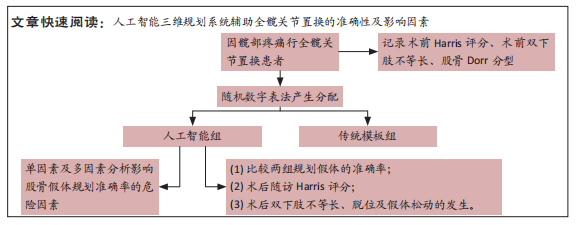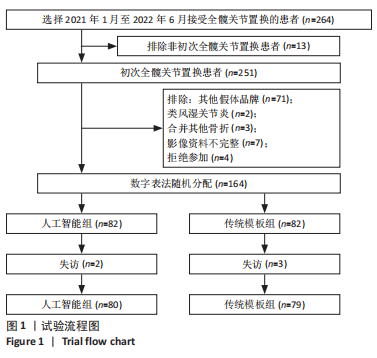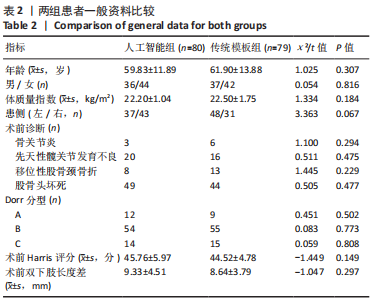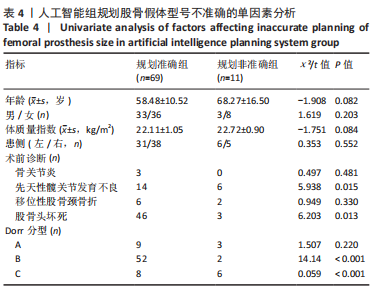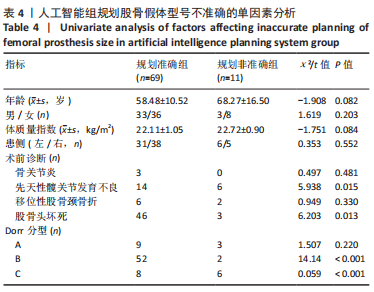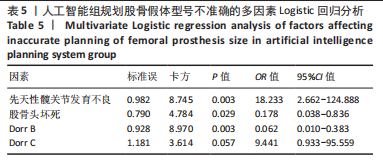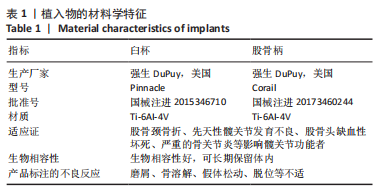[1] BRENNEIS M, BRAUN S, VAN DRONGELEN S, et al. Accuracy of Preoperative Templating in Total Hip Arthroplasty With Special Focus on Stem Morphology: A Randomized Comparison Between Common Digital and Three-Dimensional Planning Using Biplanar Radiographs. J Arthroplasty. 2021;36(3):1149-1155.
[2] TRIPURANENI KR, ARCHIBECK MJ, JUNICK DW, et al. Common errors in the execution of preoperative templating for primary total hip arthroplasty. J Arthroplasty. 2010;25(8):1235-1239.
[3] BISHI H, SMITH JBV, ASOPA V, et al. Comparison of the accuracy of 2D and 3D templating methods for planning primary total hip replacement: a systematic review and meta-analysis. EFORT Open Rev. 2022;7(1):70-83.
[4] ADAMCZYK A, LABOUDIE P, NESSEK H, et al. Accuracy of digital templating in uncemented primary total hip arthroplasty: which factors are associated with accuracy of preoperative planning? Hip Int. 2022:11207000221082026.
[5] EGGLI S, PISAN M, MÜLLER M. The value of preoperative planning for total hip arthroplasty. J Bone Joint Surg Br. 1998;80(3):382-390.
[6] CARTER L, STOVALL D, YOUNG T. Determination of accuracy of preoperative templating of noncemented femoral prostheses. J Arthroplasty. 1995;10(4):507-513.
[7] CHEN X, WANG Y, MA R, et al. Validation of CT-Based Three-Dimensional Preoperative Planning in Comparison with Acetate Templating for Primary Total Hip Arthroplasty. Orthop Surg. 2022;14(6):1152-1160.
[8] GAMBLE P, DE BEER J, PETRUCCELLI D, et al. The accuracy of digital templating in uncemented total hip arthroplasty. J Arthroplasty. 2010;25(4):529-532.
[9] GONZALEZ DELLA VALLE A, COMBA F, TAVERAS N, et al. The utility and precision of analogue and digital preoperative planning for total hip arthroplasty. Int Orthop. 2008;32(3):289-294.
[10] 丁冉, 王淇, 刘烨, 等. 人工智能三维术前规划在全髋关节置换术中的应用和准确性分析[J]. 生物骨科材料与临床研究,2022,19(2):33-38.
[11] 李兴鑫, 陈施展, 娄延举, 等. 人工智能三维术前规划在全髋关节置换术中的应用[J]. 中国新通信,2022,24(17):104-106.
[12] 万超, 董圣杰, 王诗军, 等. 人工智能辅助手术规划系统在个体化全髋关节假体精准植入中的应用[J]. 骨科,2022,13(3):204-211.
[13] 胡陈贵. 人工智能辅助全髋关节置换术三维规划系统的应用价值分析[J]. 保健文汇,2022,23(10):185-187.
[14] 吴东, 刘星宇, 张逸凌, 等. 人工智能辅助全髋关节置换术三维规划系统的研发及临床应用研究[J]. 中国修复重建外科杂志,2020,34(9):1077-1084.
[15] SCHIFFNER E, LATZ D, JUNGBLUTH P, et al. Is computerised 3D templating more accurate than 2D templating to predict size of components in primary total hip arthroplasty? Hip Int. 2019;29(3):270-275.
[16] SARIALI E, MAUPRIVEZ R, KHIAMI F, et al. Accuracy of the preoperative planning for cementless total hip arthroplasty. A randomised comparison between three-dimensional computerised planning and conventional templating. Orthop Traumatol Surg Res. 2012;98(2):151-158.
[17] REINBACHER P, SMOLLE MA, FRIESENBICHLER J, et al. Pre-operative templating in THA using a short stem system: precision and accuracy of 2D versus 3D planning method. J Orthop Traumatol. 2022;23(1):16.
[18] LIM YW, HUDDLESTON JI 3RD, GOODMAN SB, et al. Proximal Femoral Shape Changes the Risk of a Leg Length Discrepancy After Primary Total Hip Arthroplasty. J Arthroplasty. 2018;33(12):3699-3703.
[19] CHEN X, LIU X, WANG Y, et al. Development and Validation of an Artificial Intelligence Preoperative Planning System for Total Hip Arthroplasty. Front Med (Lausanne). 2022;9:841202.
[20] PETRETTA R, STRELZOW J, OHLY NE, et al. Acetate templating on digital images is more accurate than computer-based templating for total hip arthroplasty. Clin Orthop Relat Res. 2015;473(12):3752-3759.
[21] DELLA VALLE A, PADGETT D, SALVATI E. Preoperative planning for primary total hip arthroplasty. J Am Acad Orthop Surg. 2005;13(7):455-462.
[22] KRISTOFFERSSON E, OTTEN V, CRNALIC S. The accuracy of digital templating in cementless total hip arthroplasty in dysplastic hips. BMC Musculoskelet Disord. 2021;22(1):942.
[23] SERSHON RA, DIAZ A, BOHL DD, et al. Effect of Body Mass Index on Digital Templating for Total Hip Arthroplasty. J Arthroplasty. 2017;32(3):1024-1026.
[24] BOESE CK, WILHELM S, HANEDER S, et al. Influence of calibration on digital templating of hip arthroplasty. Int Orthop. 2019;43(8):1799-1805.
[25] RAMME AJ, FISHER ND, EGOL J, et al. Scaling Marker Position Determines the Accuracy of Digital Templating for Total Hip Arthroplasty. HSS J. 2018;14(1):55-59.
[26] SINCLAIR VF, WILSON J, JAIN NP, et al. Assessment of accuracy of marker ball placement in pre-operative templating for total hip arthroplasty. J Arthroplasty. 2014;29(8):1658-1660.
[27] ECKRICH S, NOBLE P, TULLOS H. Effect of rotation on the radiographic appearance of the femoral canal. J Arthroplasty. 1994;9(4):419-426.
[28] OSMANI F A, THAKKAR S, RAMME A, et al. Variance in predicted cup size by 2-dimensional vs 3-dimensional computerized tomography-based templating in primary total hip arthroplasty. Arthroplast Today. 2017;3(4):289-293.
[29] WAKO Y, NAKAMURA J, MIURA M, et al. Interobserver and Intraobserver Reliability of Three-Dimensional Preoperative Planning Software in Total Hip Arthroplasty. J Arthroplasty. 2018;33(2):601-607.
[30] HUO J, HUANG G, HAN D, et al. Value of 3D preoperative planning for primary total hip arthroplasty based on artificial intelligence technology. J Orthop Surg Res. 2021;16(1):156.
[31] DING X, ZHANG B, LI W, et al. Value of preoperative three-dimensional planning software (AI-HIP) in primary total hip arthroplasty: a retrospective study. J Int Med Res. 2021;49(11):3000605211058874.
[32] ZHAO X, ZHU ZA, ZHAO J, et al. The utility of digital templating in Total Hip Arthroplasty with Crowe type II and III dysplastic hips. Int Orthop. 2011;35(5):631-638.
[33] WUESTEMANN T, HOARE SG, PETERSIK A, et al. Bone morphology of the proximal femoral canal: ethnicity related differences and the influence on cementless tapered wedge stem designs. Hip Int. 2021;31(4):482-491.
[34] DORR L, FAUGERE M, MACKEL A, et al. Structural and cellular assessment of bone quality of proximal femur. Bone. 1993;14(3):231-242.
[35] MAVCIC B, ANTOLIC V. Cementless femoral stem fixation and leg-length discrepancy after total hip arthroplasty in different proximal femoral morphological types. Int Orthop. 2021;45(4):891-896.
|
